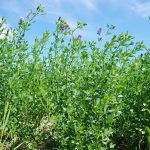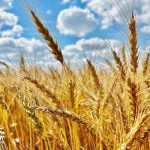Despite experiencing a million-dollar rain, beef producers are still asking how they can prepare for drought
Drought” is a word beef producers on the Prairies know well. For years, many areas in Western Canada have struggled through a prolonged drought. Although a “million-dollar rain” fell in many areas this past June, producers are still pondering lessons learned from previous years of drought, dealing with the lingering effects of several dry years, preparing for fall feeding and planning how they’ll manage future droughts.
Forages
Ag in Motion is buzzing with people in July 2024. People fill the booths and the tents have many different organizations and products on display.
Read Also

The Canadian Cattle Association’s international advocacy efforts
Global ag policies affect Canadian food policy, so the Canadian Cattle Association participates in international and domestic forums
Kurtis Reid with Masterfeeds was at Ag in Motion and spoke in an interview about the potential of using alternative feeds during drought.
“The western Canadian cow herd is still very heavily reliant on hay,” Reid said. When hay becomes scarce, producers turn to neighbours or others they know who have fed straw and barley, for example.
“So, there’s a lot to learn there about nutritional support and balance.”
Reid said during prolonged drought, the third year is when things get dire. He said in the first year, producers rely on carryover. In the second year they have to scavenge for feed, but in the third year, it’s imperative to start looking at other forage and roughage opportunities.
“The pressures of, ‘We have no feed… I don’t want to sell cows. So how can I feed them effectively?’ Then it becomes research and opportunity about, ‘Can I feed these types of weeds and how much of this type of fibre do I need to feed?’ Feed testing, ration balancing and a higher degree of precise nutrition supplementation, that’s probably one of the biggest things we’ve learned,” Reid said.
“I’m in the feed business. So we talk about that a lot in the good years, it doesn’t matter as much. But when you get into some of these tough years, where every per cent of wasted feed is just another per cent off the bottom line.”
Roger Meyers was at Ag in Motion with Union Forage. He said there are different types of forages producers can look at in times of drought, but their effectiveness largely depends on location and soil type.
He said producers should consider annual polycrops as well as forages.
“Some of our polycrops have excellent regrowth ability,” Meyers said. “Because the critical time comes from here on in, it’s hot, it’s dry. End of the year we have nothing that’s fresher.”
He said the backbone of their polycrops are biannual species because they grow green the first year and don’t try to flower until the next year.
“Wheat, oats, barley, crested wheat or alfalfas, they all have one goal for the season, which is to set seed,” Meyers said. “So if it’s too hot, too cold, too wet, too windy, a bit of a hailstorm, that seed stock is done and at the end of the year, you have nothing green. Whereas these guys get rooted down early in the year. They’ll just stagnate when it’s hot and dry.”
At the Canadian Beef Industry Conference, which took place in Saskatoon, Sask., in August, the continued concern about drought was evident. Bart Lardner, a researcher at the University of Saskatchewan, presented points on preparing for drought, even in years when rain is plentiful.
Lardner said annual cereals could be a good alternative during drought. Annuals require less moisture than perennials, so in times of drought, using annuals could be a good option. He also said producers can consider grazing cropland.
“Look at some of those salvage crops too,” Lardner said. “So you might have seeded that for a cash crop, but all of a sudden it’s looking pretty handy for pasture.”
Lardner also said kochia is a good alternative because it is drought-resistant. In previous interviews, Lardner has pointed out there are two types of kochia. Forage kochia (Bassia prostrata) is a perennial forage plant. Annual kochia (Bassia scoparia) is a notorious invasive weed known for its herbicide resistance, and which can be high in oxalates, potentially tying up calcium in livestock.
Water
Water is a big conversation during drought, whether it’s the availability or quality of the water you have.
At the Canadian Beef Industry Conference, rancher Tara Mulhern Davidson spoke about her experience on their ranch during times of drought and how they managed it. Mulhern Davidson ranches near Ponteix, Sask., with her family on their operation, known as Lonesome Dove Ranch.
“You can have the grass, you can have the feed, but if you don’t have the water, that’s kind of the limiting factor,” she said.
Mulhern Davidson said water has often been an issue, and when water levels are low you must decide if you are going to move your cattle or haul in water.
She said many considerations go into deciding what to do.
“Figure out who’s doing the water hauling. If you’re hauling with a semi and a tankard trailer, now we’re limited down to the two operators on our farm that have a 1A (license), whereas if we use big poly tanks on a flatbed, then anyone can basically do it. And then you’re not tying your semi up either, because you probably need that to haul feed into your farm if you’re hauling water.”
Mulhern Davidson emphasized the importance of testing all of your water sources. This is especially important during drought, where every drop of water counts. Once you know the water quality, you can make better management decisions.
“Do not trust your gut with water quality,” she said. “Do the test. Our worst-quality water is crystal clear, looks great. Our best-quality water is turbid, it’s cloudy, it looks terrible. So I do take water samples into the Ministry of Agriculture. We also build rations based on the water quality that we have.”
Meyers said how you graze your land can help improve the amount of water you have available, as well. He said rotational grazing can help you retain more water. This is because rotational grazing helps improve erosion and water infiltration in grassland soils.
“If you change nothing other than your ability to control the grazing, you double your water development,” Meyers said.
Management
Sometimes, even after doing all the right things, producers must make hard decisions during drought, such as culling cattle.
Mulhern Davidson said when they have dealt with drought on their operation, they retained fewer heifers than they usually would.
“Maybe we’re only keeping 100 heifers instead of 250 and then we also have really condensed our herds,” Mulhern Davidson said.
Reid said during drought, producers often don’t have a choice but to reduce herd numbers.
“When it comes into a situation of drought, it’s not like you can just buy or find more land. You have to reduce your cows to the land base that you have,” he said.
However, at some point after the drought breaks, Reid thinks ranches will retain more heifers. “Because that stocking pressure is alleviated and a diminished cow herd usually means that there has been some extra land compared to what producers had.”
Future
Though there has been rain this year, the potential for a drought isn’t negated. Lardner said the ground still needs time to recharge and soak in more water.
He said post-drought, it’s important to let your pastures rest for as long as possible so they can rejuvenate. He said he knows many producers may not be able to do this depending on how much feed they have available, but it helps the land.
“You’re going to delay, you’re going to offset any grazing, maybe those areas you came off last year in the fall, you probably won’t go until later, midsummer, or something like that,” Lardner said.
However, the value of those early June rains can’t be diminished either. They changed the course of the 2024 growing season.
“Today we are filled with a lot more optimism than a year ago today in terms of some rain,” Reid said.
“Early spring rains created grass that we haven’t seen for three to five years, maybe even up to seven years in some parts of the province, and because of that, the pressure is alleviated.”
Mulhern Davidson said drought is one of the most challenging things producers can go through. However, she said making sure you have a good community around you is important when things get tough.
“It’s not government program ad hoc payments that are going to fix this. It’s not feed that’s going to fix this. It’s not even rain that’s going to get us through this. It’s the people,” she said.
All beef producers in Canada know what it’s like to deal with drought. It’s a universal experience to wake in the morning and check the weather, scouring the forecast for rain. They all know what it feels like to watch the grass turn crisp and the dugout dry up.
And, when those grey rainclouds roll in, those producers know, better than perhaps anyone, how to dance in the rain.
“It can be really hard, but there’s no more resilient, innovative, resourceful group of people than beef and forage producers because we’re there for each other,” Mulhern Davidson said.

















